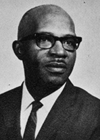Artis collection gaining significance

What was left behind by an art professor more than four decades ago may bring increased prominence for Chadron State College.
That professor was William Artis, who is often mentioned in national conversations about African American art history in the United States. Artis taught ceramics and sculpture at CSC from 1954-1966.
"William Artis has turned out to be one of those people who has become very recognized as an artist of New York's Afro-American black movement in the late ‘30s, ‘40s and ‘50s," said Richard Bird, chairman of the CSC art department.
Bird said he knows of about 20 books in which Artis has gained mention, and said the former professor's name shows up frequently on Web sites about art and black history. Bird said most of the references give little mention to Artis' time in Chadron. If they do refer to that period, the professor's place of employment is given as "Nebraska State Teachers College," the institution's former name.
Artis was born in Washington, N.C., in 1914. Records indicate that he moved to New York in 1927 where he studied sculpture and pottery at Augusta Savage Studios. He then furthered his education at Syracuse University where he earned two degrees in fine arts, a bachelor's in 1950 and a master's in 1951. Before long, Artis headed west. Bird said he's been told that Artis first came to the Great Plains to work on the Pine Ridge Indian Reservation, but soon became employed at CSC.
"He may have been the only black man in Chadron at that time," Bird said.
After leaving Chadron in 1966, he was hired to the faculty of Mankato State College in Minnesota. He taught there until 1975, just two years before his death.
While Artis' work is becoming more prized by museums and collectors, Bird believes CSC's collection may be on the brink of gaining national status. CSC has a number of pieces that Artis either left behind or that the late professor's surviving friends and students have donated to the institution.
"Most collections are lucky to have one to three pieces of his, and we're sitting on almost 20," he said.
In addition, Bird said most collections don't match the variety of Artis work found at CSC.
"Most other places have his ceramic sculptures and portraits, but we have mosaics by him, we have drawings by him, and we even have a painting by him," Bird said.
Artis' work can be found on display in Memorial Hall.
During the next few years, Bird plans to contact many significant galleries throughout the nation to let them know artwork from the CSC collection is available for their exhibits. He also wants CSC's alumni to know of the effort to build upon the collection in case they have pieces stored away they might donate to the college.
A few alumni already have been generous with their artifacts.
During an alumni gathering in Arizona, 1964 graduate Bob Yost of Kingman donated some of his Artis pieces to the college. Connie Rasmussen, executive director of the Chadron State Foundation, returned to campus with three pieces of ceramic and mounds of correspondence between Artis and Yost.
Helen Funkhouser, a 1936 graduate who lives in Loveland, Colo., donated pieces that had been given to her parents as gifts. While employed at CSC, Artis lived in her family's basement apartment on Main Street.
"He was a really nice man and my parents loved visiting with him," she said.
In addition to artwork, former students and faculty also have made monetary donations in Artis' name. Mike Chipperfield, a retired Ohio University art professor who studied under Artis and graduated from CSC in 1964, spearheaded an effort to start a scholarship endowment in Artis' name. The foundation began awarding scholarships from that account in 2005-2006.
Category: Art, Campus News
